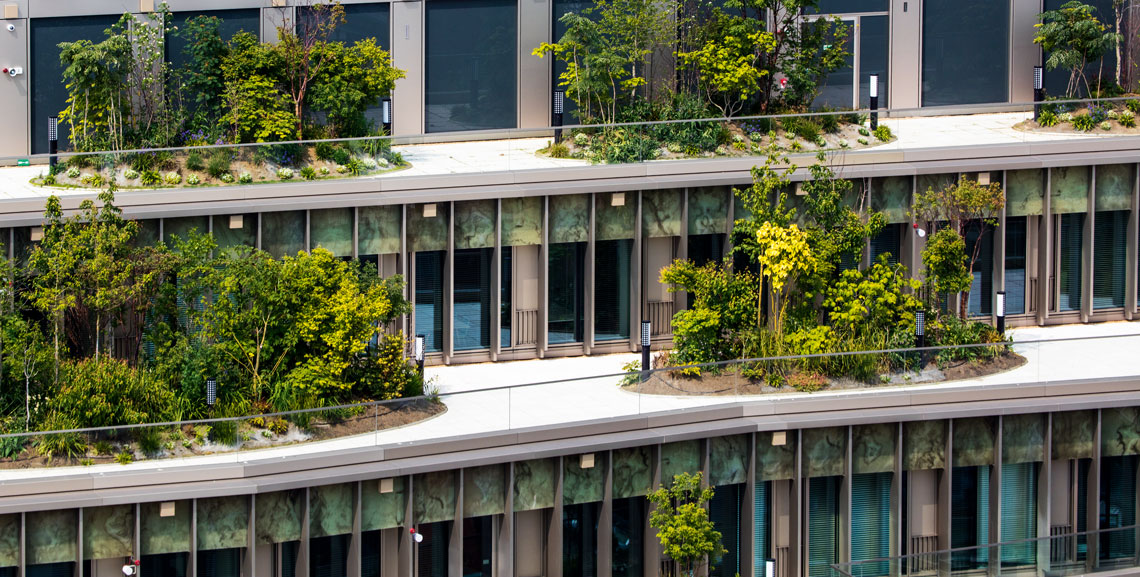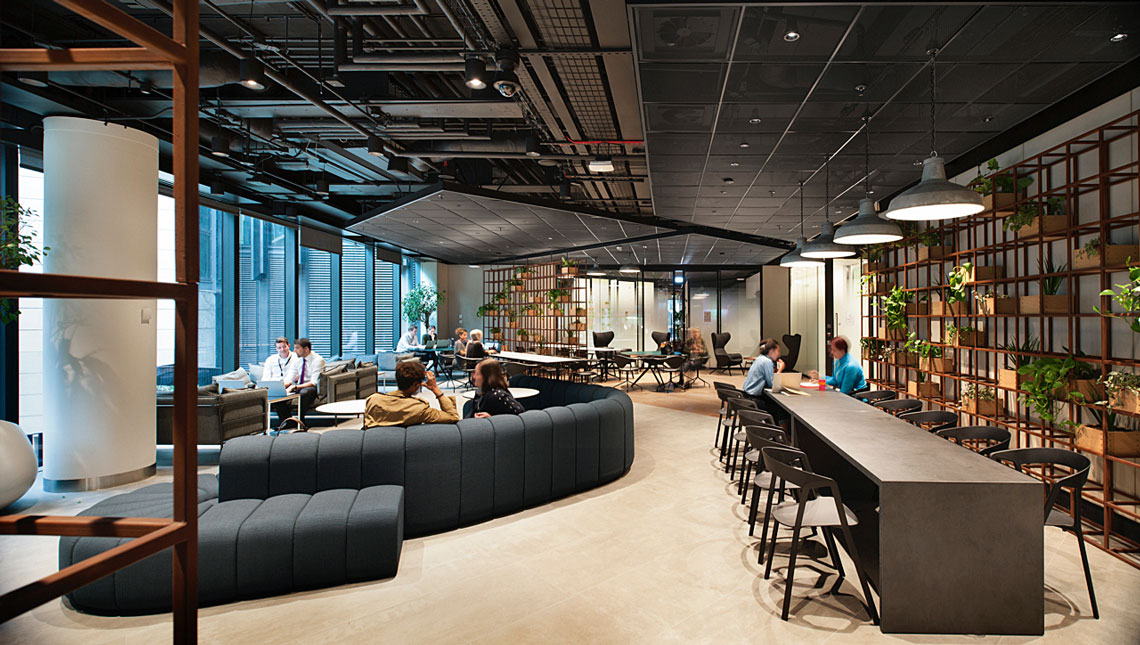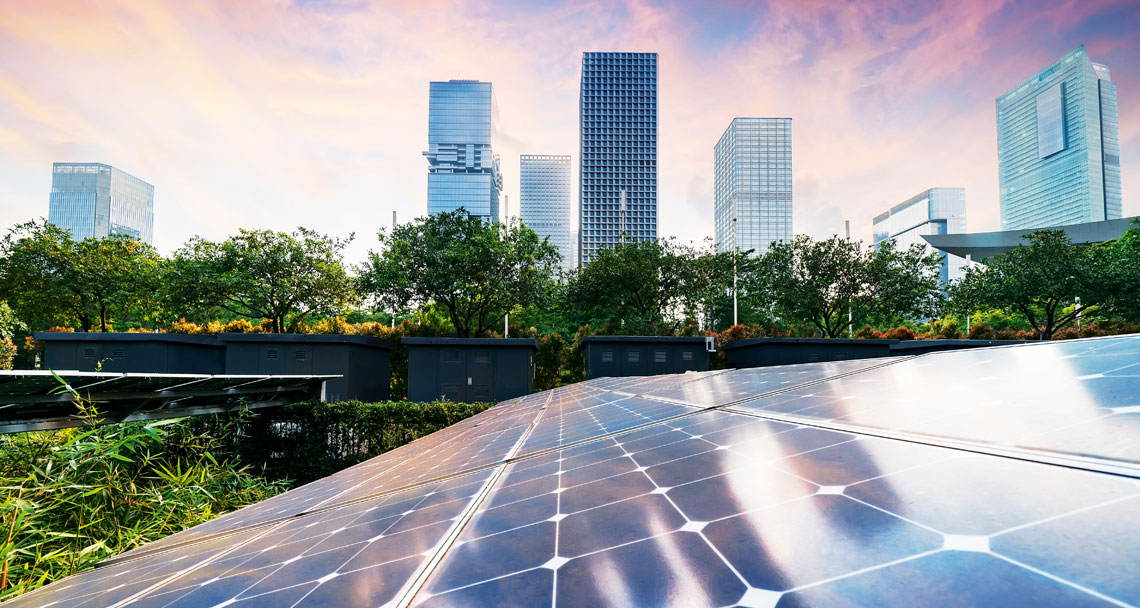How green is your workplace?
For occupiers, green credentials are moving swiftly up the agenda. Work environments that match a sustainable ethos will have greater impact on leasing decisions.
Corporates around the world are increasingly mindful of their environmental impact. Whether that’s their real estate portfolio, business travel or supply chains, companies have many reasons to reduce their carbon emissions. It’s partly reputation – not only to ensure they’re a company with ‘licence to operate’ in line with expected current moral and ethical business practices, but also that they can still attract and retain the best talent, for whom the environmental agenda has become a major priority. They also recognise that, overall, current environmental business practices are not sustainable, and – if they needed a business case – it’s also about remaining resilient.
If we consider carbon, a look at the top 100 companies globally by revenue shows 59 have already stated emission reduction goals with an average target date of 2031. The pace of commitments from these companies is speeding up: UK insurance company Aviva and tech giant Google were among the first, stating they have been carbon neutral since 2006 and 2007 respectively. However, 41% of the companies who have set targets put them in place in the past two years.
Companies tend to look at three types of targets – carbon neutral commitments, 100% renewable energy, and other science-based targets – to define clear paths to reduce emissions.
These commitments also vary by sector. Of the five tech firms in the top 100, all of them have committed to a carbon neutral target. However, that changes rapidly when it comes to the energy companies: just 12 out of 21 have similar targets.
Countering their impact on the planet is hard to fathom. For two thirds of companies reporting carbon footprints, their average emissions are more than 27 million MtC02e; this is the equivalent to the carbon sequestered by planting 454 million tree seedlings and growing them for 10 years.

The role of real estate
While that is a daunting figure, the fact that these companies are reporting and committing to targets is good news: they can take a major role in cutting target emissions. And their real estate portfolios will often be a big part of that.
While emissions will vary by company depending on their sector and whether they are service- or product-led, for many companies, the contribution from their real estate portfolio will be a major pillar of their efforts. This will show through on what type of buildings they use and how efficiently they are operated.
Green buildings
On an asset level, companies have been focused for some time on improvements across their portfolios through the use of environmental certification. Research by BREEAM (a leading sustainability assessment company) in 2016 found that the average CO₂ saving for a BREEAM-assessed building is 22%, while a BREEAM Excellent building is expected to reduce carbon emissions by 33%. Reduction in carbon emissions for those buildings rated Outstanding – the upper end of BREEAM’s scale – are expected to be even higher at 66%.
A similar study by University of California, Berkeley, found that LEED-certified buildings (another leading assessor) produced half as many greenhouse gas emissions based on lower water consumption than baseline buildings, 48% less arising from solid waste management, and 5% less due to lower levels of transportation. While both these reports are more than five years old, improvements in building technology and construction should mean these levels have at least been sustained, if not improved upon.
Green premium
While occupiers are embracing the green agenda, it is still difficult to understand if they are willing to pay more for top-class environmental buildings. There are studies that show buildings with green certificates command more rent – in Manchester, UK, Savills research has shown that 76% of offices let above £30 per sq ft had a BREEAM rating of at least Very Good, rising to 100% of buildings let above £35 per sq ft. The Landmark office development is let at the city’s current top rent of £38.50 per sq ft and boasts a BREEAM rating of Excellent.
It is the case that these better, green buildings are often the newest, so it’s hard to separate the premium rent they command from their environmental credentials. However, research from Green Street Advisors also found that green buildings have better occupancy levels.

The work from home shift and carbon footprints
A debate has emerged about whether working from home or the office is more environmentally friendly. A number of factors need to be considered – the most obvious being transport and energy use.
The International Energy Agency (IEA) suggests that working from home will normally reduce net energy demand for a household that commutes by car, but only if that journey is greater than about 6km. Any shorter, and working from home could increase CO₂ emissions due to extra residential energy consumption. For those commuters taking public transport, working from home is likely to increase energy demand.
There has naturally been a large uptick in residential energy usage through the pandemic. The IEA says that, initially, overall energy use during lockdown fell by 20% and patterns for residential mirrored Sunday energy consumption levels.
The impact on emissions also depends on whether fossil fuels or renewables are being used. Different seasons and climates also need to be considered.
One office building that is cooling or heating many workers may be more efficient than lots of dwellings trying to achieve the same levels.
The IEA is optimistic that flexible working would have a positive effect. It estimates that if all office workers worked from home for one day a week, it would save 1% of global oil consumption for road passenger transport each year. Factoring in the increase in energy use still results in an annual decline of 24 million tonnes, the equivalent to most of Greater London’s annual CO₂ emissions.
“One office building that is cooling or heating many workers may be more efficient than lots of dwellings trying to achieve the same levels”
The investor’s perspective
While evidence is scarce that occupiers are willing to pay more for green buildings, it is more likely that unfit office space without green credentials is much less likely to be considered. At present, it is less a green premium and more a brown discount.
However, that brown discount belies a much greater challenge for owners who do not follow a green approach. There are growing transitional risks from climate change associated with buildings as we move towards a cleaner, greener economy.
Investors who do not meet desired criteria or government regulations face owning stranded assets, those properties that will be at risk of early economic obsolescence. Many investors are getting ahead now to futureproof their assets by upgrading them, changing their use or selling.

The industry is also developing ways to support owners, such as with the Carbon Risk Real Estate Monitor (CRREM). This tool helps owners identify the trajectory for annual energy and carbon intensity use for individual assets until 2050 to stay in line with keeping global warming below 2°C (3.6°F).
Across portfolios of European office REITs, research shows that for every 5% increment in a portfolio that is certified green, the occupancy rate of a company improves by 85 basis points compared to those with fewer overall green assets. There is also evidence that green buildings link to employee satisfaction and wellbeing. A World Green Building Council report studied 11 facilities globally that had one or more green certification. In each case, employee absenteeism was reduced and employees felt more productive and healthier.
Landlord/tenant relationship
In the US, the conversation between landlords and occupiers has not been affected by the impact of Covid-19.
“The pandemic has actually increased the focus on the green credentials of buildings with an emphasis on healthy places as well as energy efficiency,” says Jess Johnson, Head of Cross Border Tenant Advisory – Americas, Savills. “How tenants are going to use the space may well be in flux as we return to the office, but environmental sustainability continues to be a top priority.”
Another strategy for occupiers is to make sure they benefit from the lower energy and operational costs from buildings, and this will depend on the agreements they have with the landlord. “Occupiers are able to formalise their ambitions for reducing the impact of their real estate through a green lease. This enables both them and the landlord to set out expectations for environmental targets and data collection and sharing,” says Tanya Broadfield, Director of Sustainability, Savills UK.
Green leases are now becoming more common. There is no internationally standardised method of classifying leases as green; they usually refer to a lease or a supplementary document that helps manage and improve the performance of a building with commitments by both the landlord and occupier. “With occupiers and landlords working together, any green lease will ideally enhance the environmental and social performance of a building, help to mitigate any sustainability regulations and market risk and also foster improvements in data collection for reporting,” says Broadfield.

Deloitte’s Gavin Harrison and Philip Mitchell explain how the company’s commitment to sustainability puts their people and the environment at the heart of the workplace
Creating a workplace for people and the planet
As one of the big four professional services firms, Deloitte’s network of global offices comes with the territory. Consequently, it is taking seriously its commitment to reduce the impact of its real estate portfolio on the environment. That starts with a simple philosophy: only have as much space as you need.
“This concept of rationalisation and right-sizing is really supportive of sustainability, as you are also going to need less energy to heat the building, less water, fewer materials when we fit it out, so it’s a really powerful thing,” says Gavin Harrison, Internal Sustainability Lead at Deloitte UK & North and South Europe.
Green credentials are high on the agenda
Overseeing a portfolio for 22,000 workers over 1.5 million sq ft across the UK, and parts of Deloitte North and South Europe, the team uses lease events to bring that sizing efficiency as well as upgrade any building’s green credentials.
“It’s definitely higher up the agenda in terms of landlords understanding that it’s a tenant requirement,” says Philip Mitchell, Director, Head of Estate Management at Deloitte UK. He notes that in markets where Deloitte is looking at relocation spaces for its offices that most other occupiers active in those markets are now also placing increased importance on their sustainability requirements.
Selecting sustainability
Once buildings are selected, the fit-out process follows Deloitte’s own environmental standards which, depending on size and location, work to recommended BREEAM Excellent or, for buildings over 5,000 sq m, BREEAM Outstanding. Deloitte’s HQ at One New Street Square, London is one of its BREEAM Outstanding buildings.
It will also agree a memorandum of understanding on environmental operations with its landlords, which is akin to a green lease. This sets out agreements on Deloitte receiving regular data from the landlord, the way energy is sourced and ensuring buildings are zero waste to landfill. Harrison says the agreement basically states: “We’d like to work collectively to make sure that the building’s energy use is tracked monthly and you’re encouraging energy efficiency.”
Employee focus
Deloitte’s focus on real estate slots into the wider green agenda of which employees are increasingly mindful.
“When someone joins the firm, they like to know we’ve got our net zero ambitions,” says Harrison. And, while issues such as reducing business travel are more critical in terms of behaviour change, real estate’s efforts are still an important visible contributor. “They experience the building that they’re working in, therefore they believe that you have this agenda,” he adds.



